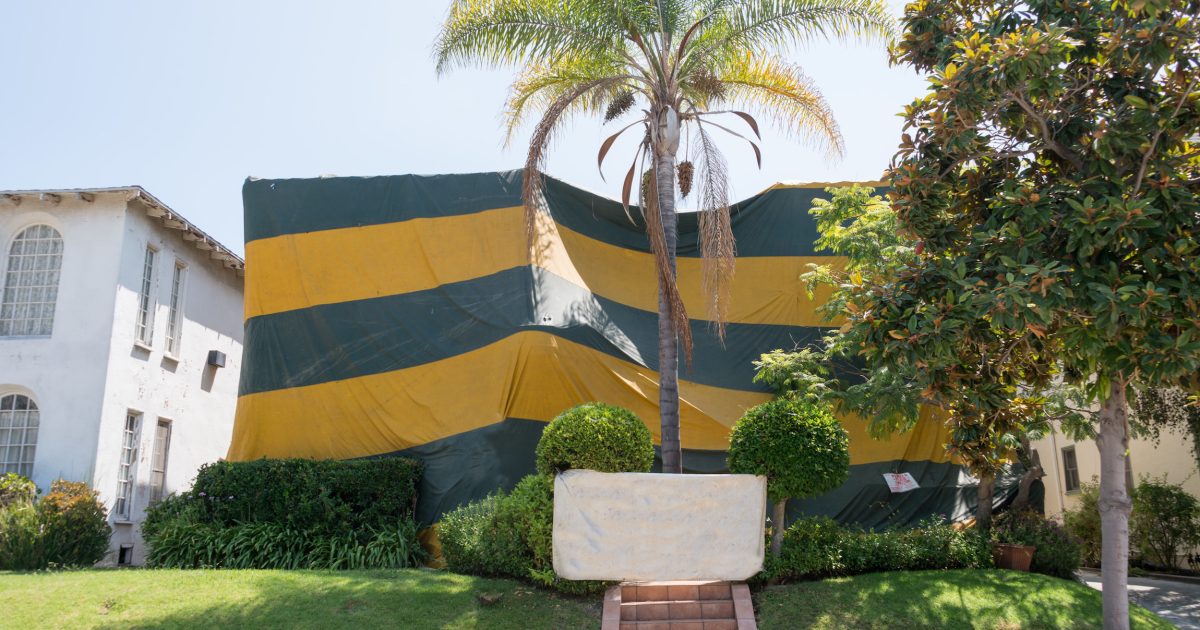
When you have widespread, severe, partly inaccessible and/or difficult to locate drywood termite infestations, structural fumigation is recommended. Milder infestations often are treated with termiticides injected directly into the wood or localized heat treatment.
What is tenting?
Tenting which is also known as termite fumigation, is one of the treatment options for dealing with active drywood termites. Localized “spot” treatment controls only the drywood termite activity in the specific area and often involves drilling into infested areas. It is usually a last resort for pest infestations.
Tent Fumigation
Tent fumigation is the only option when infestation is so severe especially in inaccessible area. Termites are able to live in areas that we don’t necessarily see such as walls, beams, and underneath floorboards.
During a tent fumigation the gas reaches every area and deeply penetrates its wood structures where termites live and feed. Once the home is completely aerated and cleared properly, it leaves behind no residue on household items.
Homeowners should be aware of the details involved in the process:
- Can be expensive.
- It is not a prevention method. It does not offer protection against future colonies of termites.
- Inconvenient since the property must be vacated.
- Lots of prep work – must remove occupants, pets, medicine, food, plants, open containers, and cosmetics.
- All flames must be extinguished, including pilot lights of water heaters, gas refrigerators, ranges, ovens, broilers, etc. Gas service must be disconnected.
- Pest control expert needs to test each room to make sure the house has been aerated properly before re-entry.
Heat Treatment
Heat treatment uses heat instead of chemical gas to kill the termites in your home. Again, the house is sealed off completely with a “tent” but instead of being filled with insecticide it is filled with heat that the termites cannot withstand.
How long does it take?
It varies for the length of time required for a fumigation. The fumigation process can take anywhere from six hours to one week. It depends on the level and type of infestation, dosage, temperature, size of the house, and other factors.
Non-Fumigation Solutions
The two most predominant methods outside of fumigation are liquid pesticide and heat treatments. Both are similar to fumigation.
Liquid Pesticide Treatments
These are actually spot Treatments which involve drilling multiple holes into the infested areas of flooring and walls so that a termiticide can be injected. Treatment provides lasting effects for protection against future swarms. No tent is required for this treatment.
Heating
Heat-based treatments which requires tenting have proven to be effective against termite swarms. Heating raises the temperature of the wood throughout a home for a minimum of 35-60 minutes to 120-130 degrees. When localized colonies can be identified it is effective. It can cause damage to heat sensitive belongings (wiring, vinyl, furniture, electronics, beauty supplies, etc.) so they need to be removed prior to the process.
If you see any signs of termites, call a professional pest control company sooner than later to handle it for you? If you wait, an entire colony can take over and you won’t have options at that point.
Drive-Bye Exterminators offers home and commercial pest control services in Clearwater, Florida, and the surrounding areas. Family owned and operated for over 25 years, Drive-Bye Exterminators has state certified inspectors and exterminators provide roach, subterranean termite, dry wood termite, roaches, spider, ant and flea services to both commercial and residential clients. Whether a business owner needs help getting rid of a termite infestation, or a homeowner wants to rid their kitchen of ants, Drive-Bye Exterminators offers each client the same level of professionalism and excellence.
Request a FREE Pest Control or Termite Inspection today with the Professionals of Drive-Bye Exterminators. Contact Us Today at 727-787-2127.






